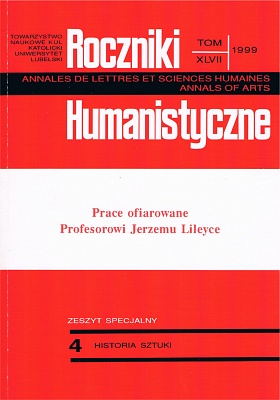How the Monument of Voivode Piotr Firlej was Created in Lublin
Abstract
The wall sepulchral monument is located in the north aisle of the Dominican Church in Lublin. A reclining figure of a man in a long robe is presented in it. The man is holding a book in his hand and has a skull under his elbow. It is a late-Renaissance work, probably made in a mason's workshop in Pińczów, in the circle of Santi Gucci.
In the relevant literature, for 90 years the work has been considered to be the monument of the Lublin Voivode Piotr Firlej, who died in 1619. The coat of arms Lewart placed in the upper alabaster cartouche as well as the Latin, painted inscription that until recently could be seen in the lower, longitudinal one, are supposed to be proof of it.
The author of the article challenges the statement that the monument is the tombstone of Piotr Firlej. The Voivode descended from an illustrious family of knightly aristocracy and hence he should be presented, in accordance with his estate, in armour, as vir armatus. Anyway he was buried in Krosno. The cartouche with the coats of arms Lewart and Jelita was put at a later time on the cartouche with the badge that had been destroyed. Anyway the coat of arms used by the Firlejs was placed on the left heraldic side; hence it referred to a woman married to a man whose coat of arms was Jelita. Originally the monument commemorated a local patrician (perhaps a clerk at the Lublin Tribunal).
Only in the middle of the 19th century was the monument put in the Dominican Church; originally it had probably been built in St. Michael Collegiate Church that was pulled down in 1846. During its dismantling it was stripped of its architectonic framework. By placing a new inscription on its lower part and exchanging the coat of arms transferred from another tombstone, the monument was dedicated to Piotr Firlej. This pseudo-historical transformation was probably the work of the then prior, Ignacy Szeliga. He was guided by the wish to increase the number of historical monuments in order to add to the importance of the church that was threatened with demolition.
Copyright (c) 1999 Roczniki Humanistyczne

This work is licensed under a Creative Commons Attribution-NonCommercial-NoDerivatives 4.0 International License.





